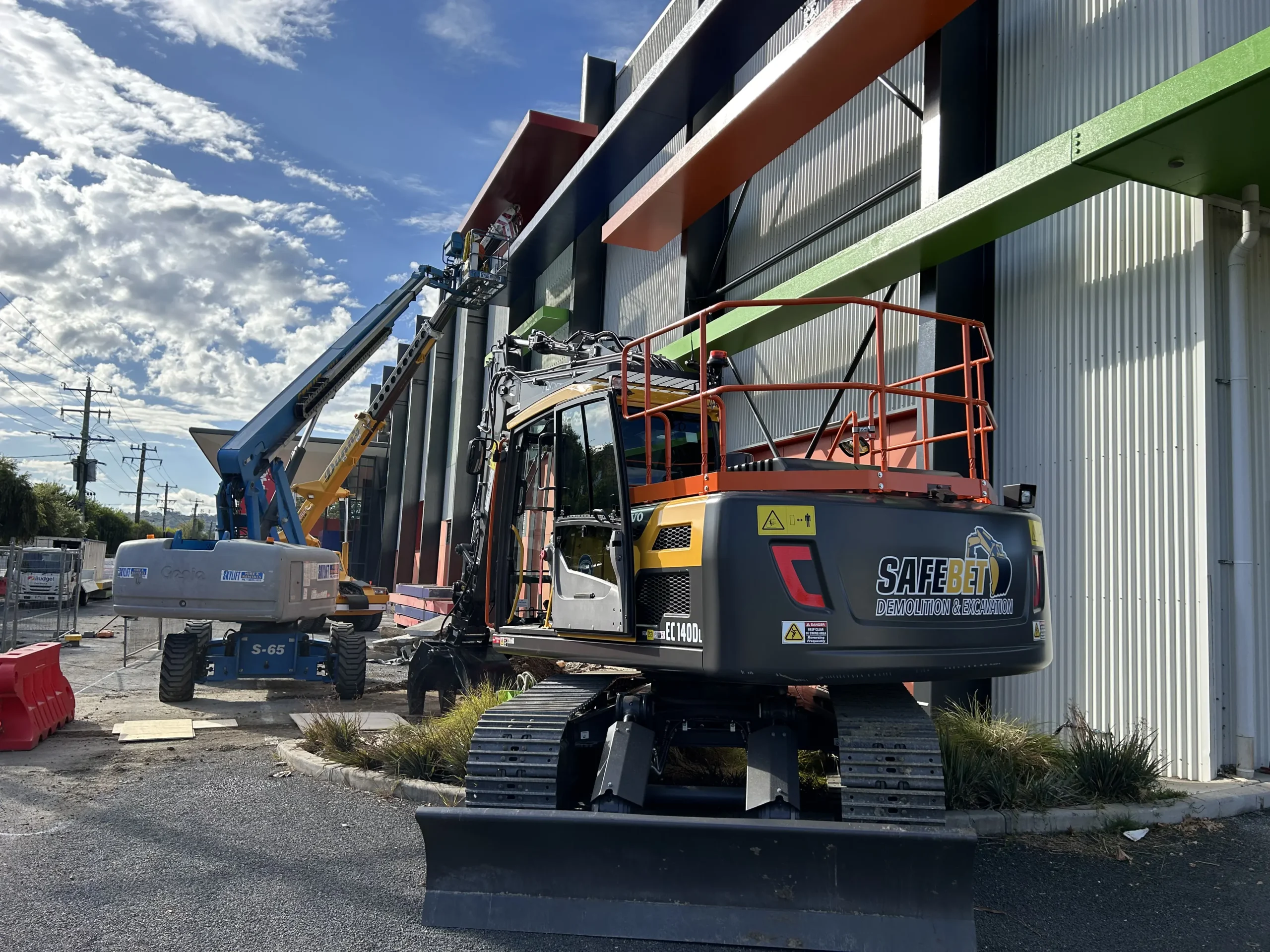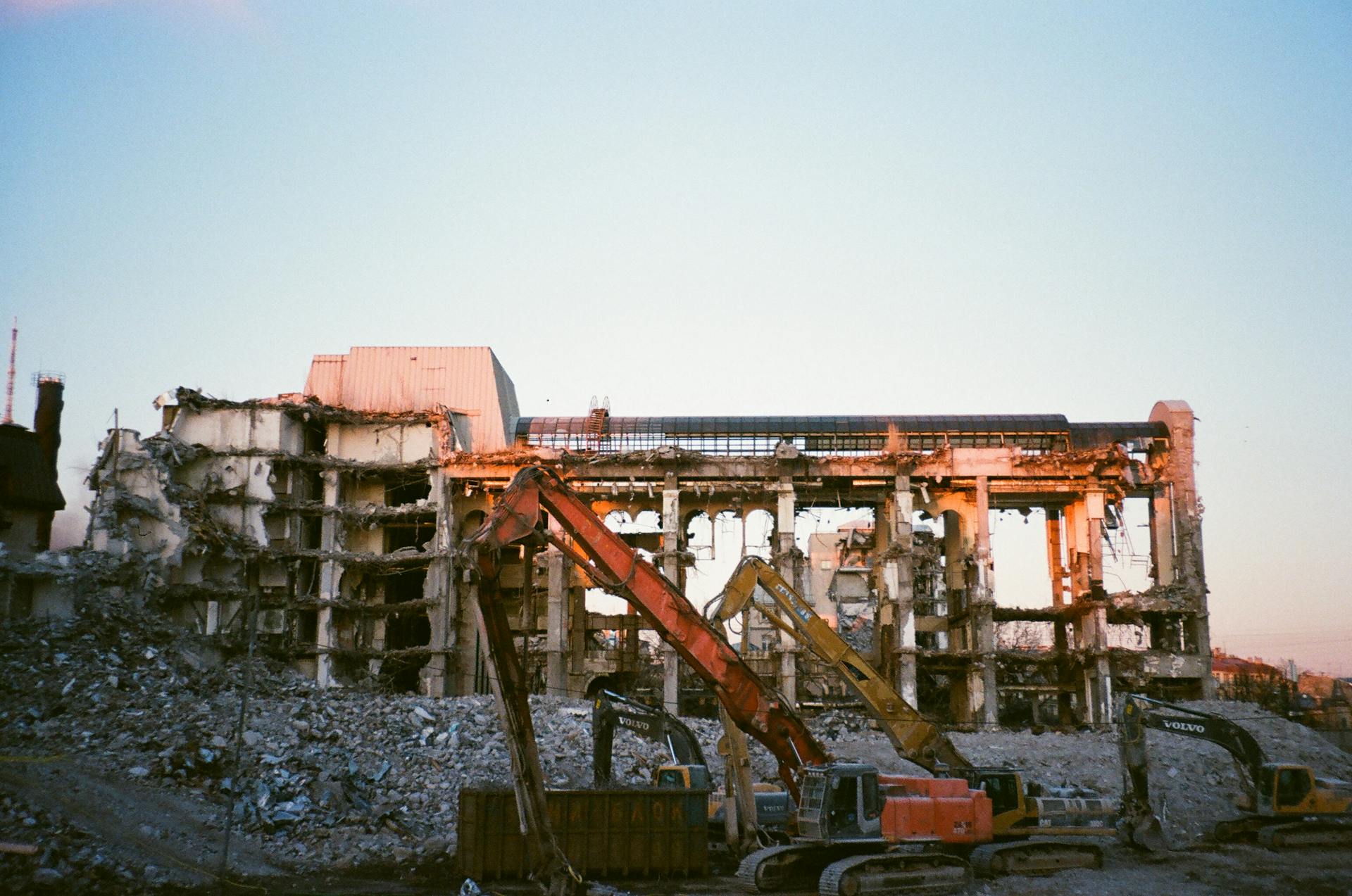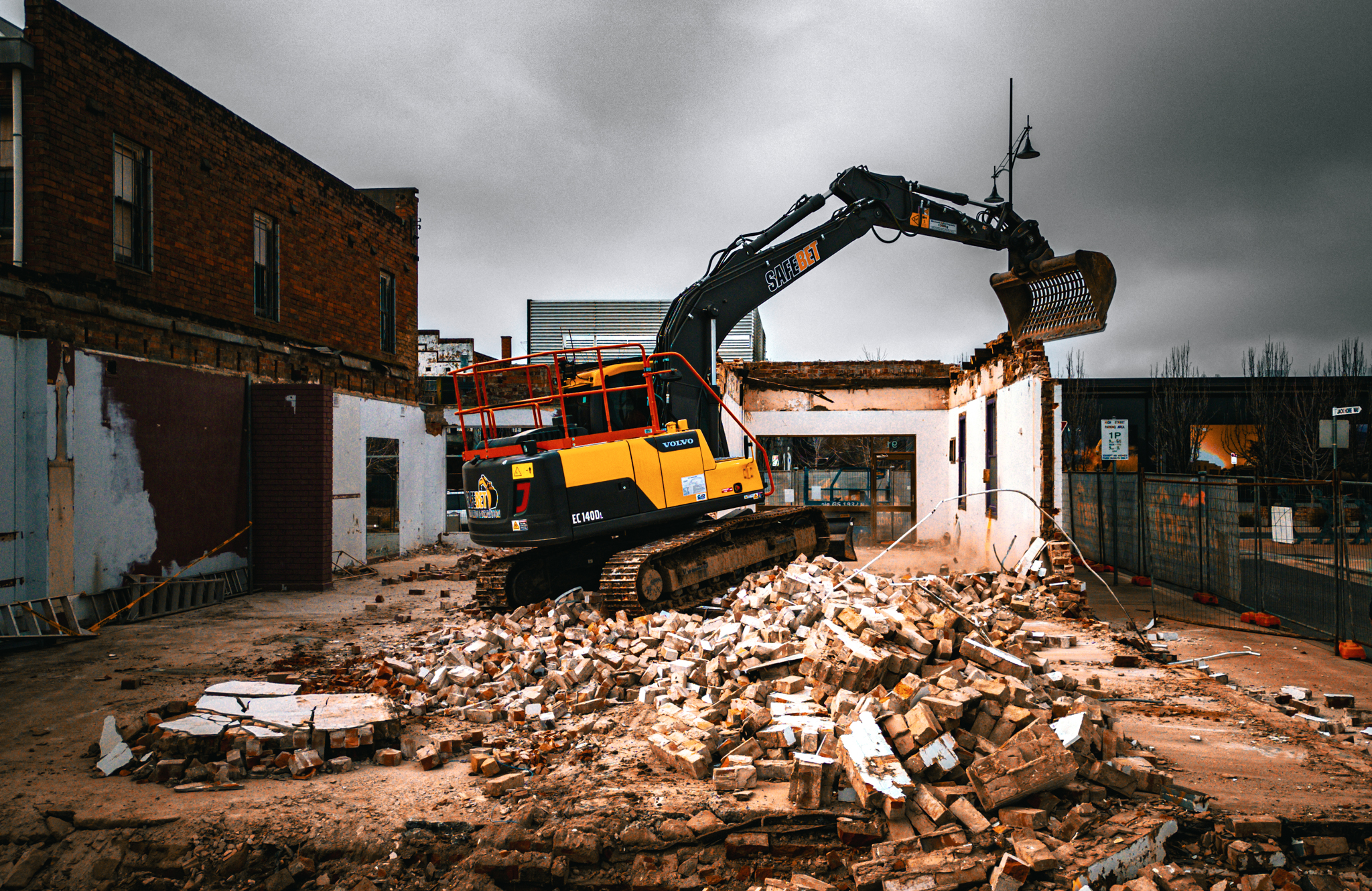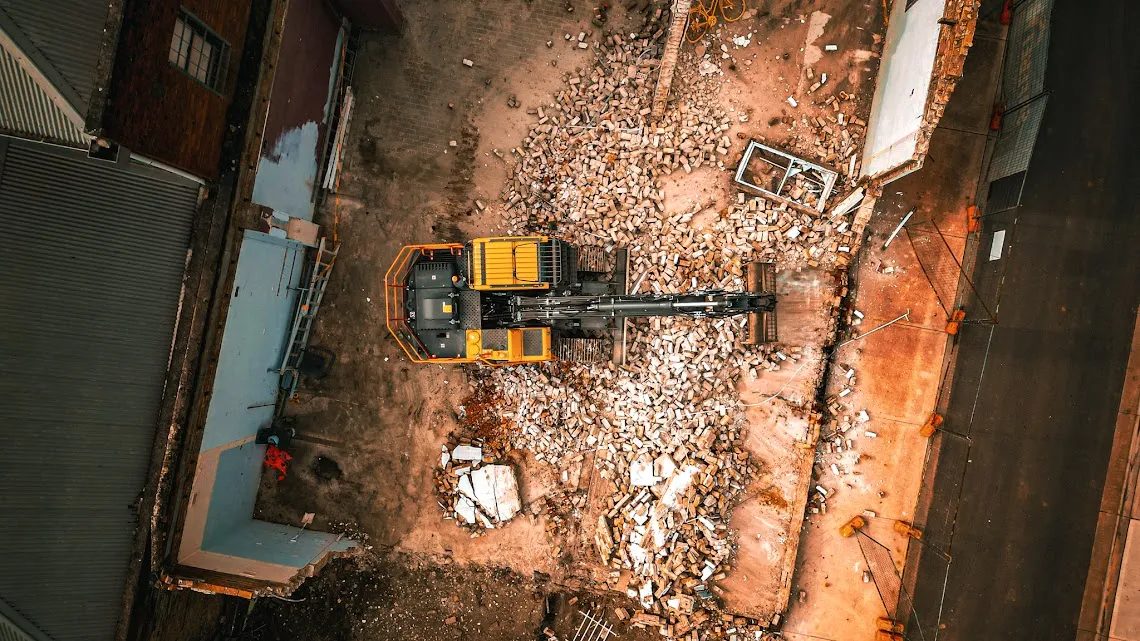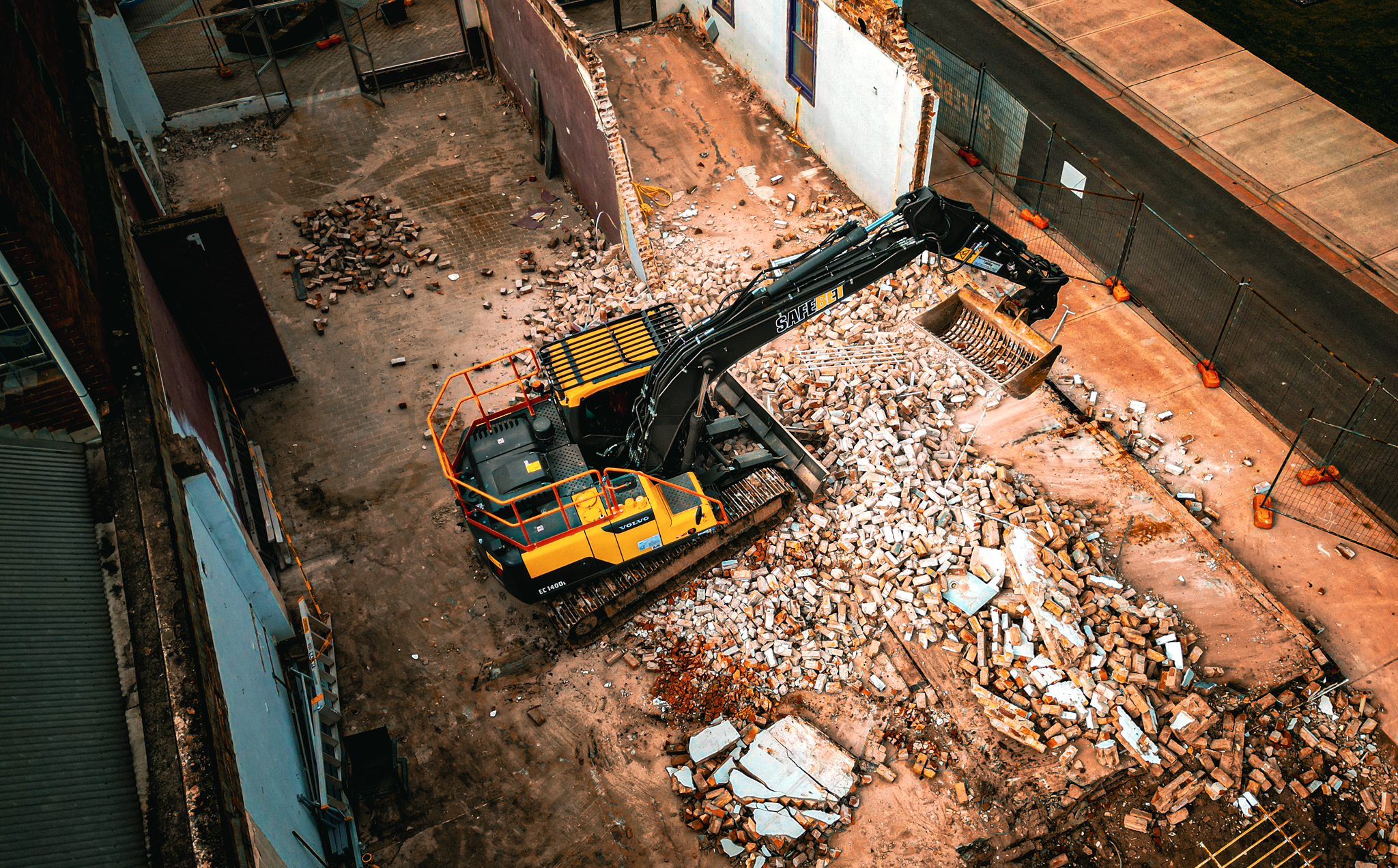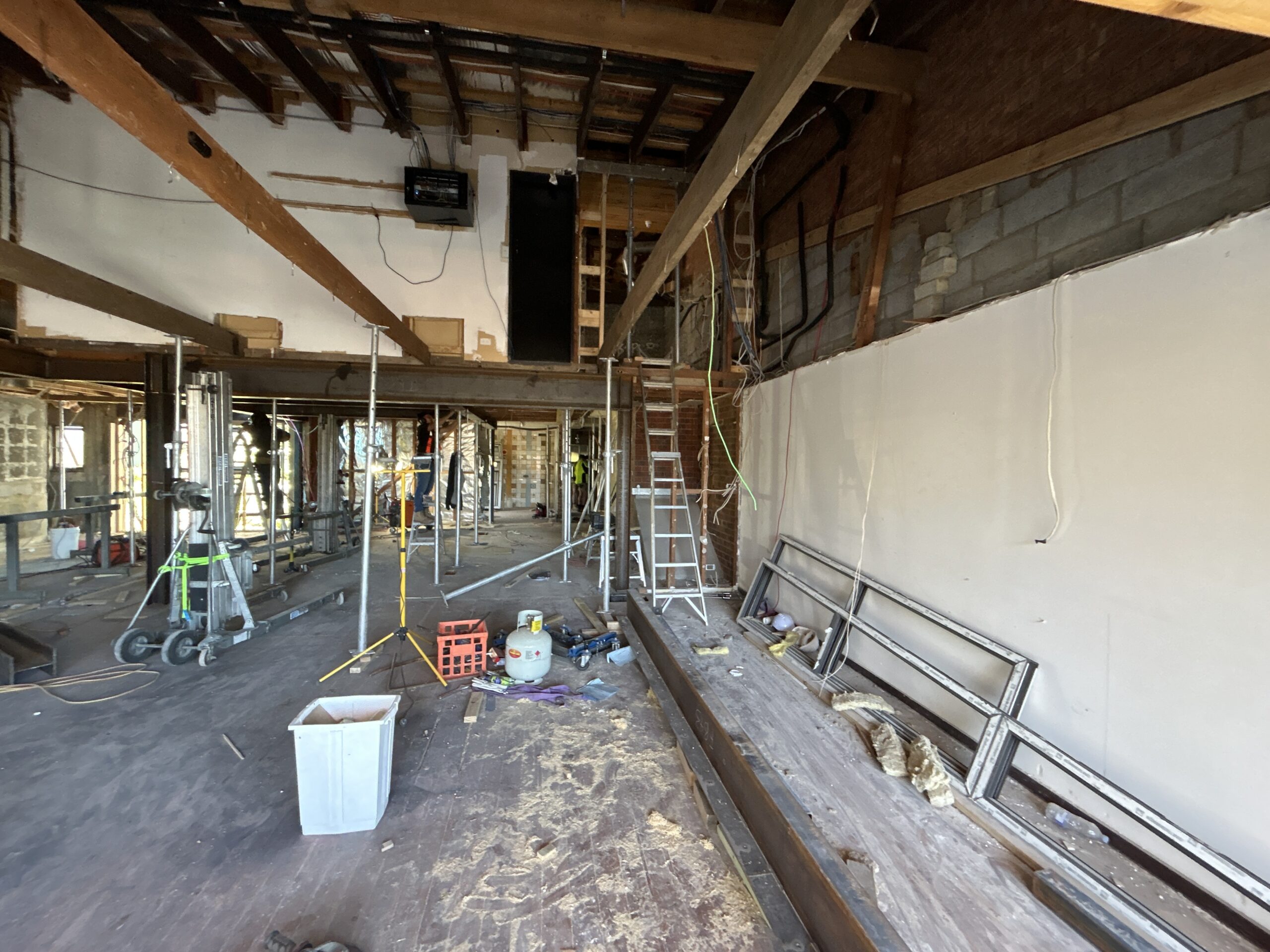At a glance:
- Specialised technique for dismantling structures in confined spaces.
- Limited workspace, structural concerns, environmental considerations, and access restrictions.
- Innovative space optimisation, temporary support structures, and remote-controlled equipment.
- Rigorous risk assessment, compliance with regulations, proper training, and emergency preparedness.
- Compact demolition tools, robotic equipment, selective demolition methods, and high-reach machinery.
Tight access demolition refers to the process of demolishing structures in confined or restricted spaces where usual demolition methods may not be feasible or practical. This specialised technique involves using innovative tools, equipment, and strategic approaches to safely and efficiently demolish buildings or structures within tight spaces such as urban areas, buildings surrounded by other structures, or areas with limited access. The goal is to perform the commercial demolition work with precision, minimising disruptions to surrounding areas while ensuring safety and adherence to regulatory standards.
Are you ready to delve into the world of tight access demolition? Brace yourself for an eye-opening journey through the intricacies of this specialised field. From limited workspaces to innovative solutions, we’re about to uncover the essential insights that every demolition enthusiast needs to grasp.
Need for Tight Access Demolition
Limited space
In densely populated urban areas or sites surrounded by other structures, there’s often limited space to manoeuvre heavy machinery or conduct large-scale commercial demolition activities safely. Tight access demolition methods are designed to work within these space constraints without compromising safety or efficiency.
Preserving surrounding structures
When demolishing a building in proximity to other buildings, infrastructure, or sensitive areas, traditional demolition techniques can pose risks of collateral damage. Tight access methods allow for precise and controlled dismantling, minimising the impact on surrounding structures and minimising the risk of accidents or structural failures.
Reducing disruptions
Traditional demolition methods can cause significant disruptions to traffic flow, nearby businesses, and residential areas. Tight access demolition focuses on targeted dismantling, which helps minimise disruptions and allows for more efficient project management, especially in busy urban environments.
Enhanced safety
Working in tight spaces requires specialised equipment, tools, and techniques to ensure the safety of workers, pedestrians, and nearby properties. Tight access demolition prioritises safety measures such as structural assessments, debris containment, and controlled demolition practices to mitigate risks associated with confined spaces.
Environmental considerations
By using precision demolition methods, tight access demolition reduces the generation of debris and waste, leading to more environmentally friendly practices. It also allows for better management of hazardous materials and promotes recycling or proper disposal of demolition waste.
Cost efficiency
Despite the complexities involved, tight access demolition can be more cost-effective than conventional methods in the long run. This is because it minimises labour costs, material handling expenses, and the need for extensive site preparation, making it a practical choice for projects where space and efficiency are critical factors.
Common Challenges in Tight Access Demolition
Limited workspace and manoeuvrability
Tight access demolition often occurs in spaces where there is minimal room to move and operate heavy machinery. This challenge requires precise planning and execution to ensure that commercial demolition activities can be carried out safely and effectively within these confined areas.
Structural integrity concerns
The structural stability of both the building being demolished and surrounding structures is a critical consideration. Working in tight spaces adds complexity to assessing and managing structural risks, requiring thorough inspections and the implementation of appropriate demolition techniques to prevent unintended damage or collapses.
Environmental considerations
Demolition projects must adhere to environmental regulations and minimise their impact on the surrounding environment. In tight access scenarios, containing dust, noise, and debris becomes more challenging, necessitating the use of mitigation measures such as dust suppression systems, noise barriers, and proper waste management practices.
Access Restrictions
Limited access points or challenging entryways can hinder the movement of equipment and materials needed for demolition. Overcoming these access restrictions may involve creative solutions, such as using specialised equipment or modifying demolition approaches to accommodate tight spaces.
Logistical Hurdles
Coordinating resources, personnel, and schedules in tight access environments requires careful planning and coordination. Logistical challenges can arise from limited space for staging areas, the need for efficient material handling, and ensuring the safety of workers operating in confined spaces.
Solutions for Navigating Tight Spaces During Demolition
Innovation in space optimisation
Tight access demolition experts rely on innovative solutions to optimise space utilisation effectively. This includes the development of temporary support structures that enhance stability and safety during demolition activities. These structures are strategically designed to provide reinforcement and support where space constraints limit traditional methods, ensuring that demolition work can proceed efficiently and securely.
Temporary support structures
These structures play a crucial role in maintaining stability amidst the chaos of demolition. They are tailored to the specific needs of the project and may include bracing systems, shoring elements, or engineered supports that bolster the integrity of the structure being demolished and adjacent structures. By deploying temporary support structures, demolition teams can navigate tight spaces with confidence, minimising risks and ensuring structural safety throughout the process.
Use of remote-controlled equipment
The use of remote control equipment enhances precision and safety in confined environments, allowing operators to remotely operate machinery and tools with accuracy, reducing the need for physical presence in tight spaces. Moreover, implementing modular demolition techniques enables efficient disassembly of structures into manageable components, facilitating easier removal from constrained areas.
Safety Considerations in Tight Access Demolition
Rigorous risk assessment and management
Safety is paramount in tight access demolition projects, with a comprehensive approach to risk assessment and management. This involves identifying potential hazards associated with the demolition process, such as structural instability, environmental risks, and equipment-related dangers. By conducting thorough risk assessments, demolition teams can develop proactive strategies to mitigate risks and ensure a safe working environment.
Compliance with safety regulations
Adhering to safety regulations and standards is non-negotiable in tight access demolition. This includes following industry-specific guidelines, local building codes, and occupational safety regulations. Compliance ensures that all demolition activities are conducted safely and legally, minimising the risk of accidents, injuries, and regulatory violations.
Importance of proper training and equipment
Training plays a critical role in ensuring the safety of personnel involved in tight access demolition. Demolition workers should receive comprehensive training on equipment operation, safety procedures, hazard recognition, and emergency response protocols. Additionally, using appropriate personal protective equipment (PPE) and specialised demolition tools further enhances safety measures on site.
Emergency preparedness
Preparedness for emergencies is paramount in tight access demolition projects. This includes developing and implementing emergency response plans, conducting regular safety drills, and ensuring that all personnel are familiar with evacuation procedures and emergency contacts. Prompt and effective responses to unforeseen circumstances, such as accidents, equipment failures, or environmental hazards, can mitigate potential risks and minimise the impact on personnel and property.
Equipment and Techniques for Tight Access Demolition
Compact demolition equipment
Mini-excavators:
These compact machines are specifically designed for working in tight spaces. They offer the versatility to perform various demolition tasks such as breaking concrete, removing debris, and excavating in confined areas.
High-reach excavators:
Similar to mini-excavators but with extended reach capabilities, high-reach excavators are essential for accessing elevated structures in tight spaces. They provide the necessary height and reach without compromising stability, making them ideal for demolishing upper floors or tall structures.
Robotic demolition equipment:
Robotic demolition tools, such as demolition robots with specialised attachments, enable precise and controlled demolition in areas where human access is limited or hazardous. These robots can be remotely operated, allowing operators to work safely from a distance while maintaining accuracy and efficiency.
Selective demolition techniques
Skilled operators:
Selective demolition requires experienced operators who can assess structural integrity and determine the best approach to remove specific elements of a structure while preserving others.
Specialised techniques:
Techniques such as diamond wire sawing, concrete cutting, and controlled dismantling are used for selective demolition. These methods allow for precise cuts and controlled removal of targeted sections, minimising disruption to the surrounding environment.
High-reach demolition
Equipment features:
High-reach demolition equipment is equipped with extended booms and specialised attachments that enable operators to reach tall structures while working in tight spaces. This equipment provides the necessary height and stability to perform demolition tasks at elevated heights without compromising safety.
Unique capabilities:
High-reach demolition equipment is uniquely suited for demolishing upper floors of buildings, removing sections of tall structures, or accessing areas with limited clearance. Its ability to reach heights while maintaining stability makes it an essential tool for tight access demolition projects.
Planning and Preparation for Tight Access Demolition:
Meticulous Site Assessment
Before initiating tight access demolition, a thorough site assessment is conducted to evaluate the structural condition, accessibility, and surrounding environment. This assessment provides crucial insights into the challenges and constraints of the site, guiding the development of a detailed demolition plan.
Detailed Demolition Plan
Based on the site assessment, a comprehensive demolition plan is formulated, outlining the sequence of demolition activities, safety protocols, equipment requirements, waste management strategies, and environmental considerations. The plan ensures that every step of the demolition process is guided with precision, minimising risks and maximising efficiency.
Coordination with Local Authorities and Utilities
Tight access demolition projects require coordination with local authorities, building departments, and utility providers to obtain necessary permits, approvals, and utility shutdowns. This coordination ensures compliance with regulatory requirements and minimises disruptions to essential services during the demolition process.
Contingency Planning
Despite meticulous planning, unforeseen challenges may arise during tight access demolition. Therefore, contingency planning is essential to anticipate and address potential issues such as adverse weather conditions, equipment malfunctions, site access constraints, or unexpected structural discoveries. Having contingency plans in place allows for swift and effective responses to mitigate risks and maintain project progress.
Tight access demolition is a specialised technique used to dismantle structures in confined spaces, such as urban areas or sites surrounded by other buildings. It involves innovative tools, strategic approaches, and a focus on safety and efficiency. This method is necessary due to limited space, the need to preserve surrounding structures, and reducing disruptions in busy environments. Challenges include limited workspace, structural concerns, environmental considerations, access restrictions, and logistical hurdles.
Solutions include innovative space optimisation, temporary support structures, and the use of remote-controlled equipment. Safety considerations are paramount, with rigorous risk assessment, compliance with regulations, proper training, and emergency preparedness. Equipment and techniques include compact demolition equipment, robotic tools, selective demolition techniques, and high-reach demolition equipment. Planning and preparation involve meticulous site assessment, detailed demolition plans, coordination with authorities and utilities, and contingency planning. Tight access demolition showcases the intersection of innovation, precision, and safety in addressing the challenges of confined space demolition in urban environments.
